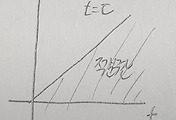20.1. Differentiation of Transforms.
Laplace transform 한 함수를 미분해 봅시다.
$F(s) = \int_{0}^{\infty} e^{-st} f(t) dt$ (1)
(1)을 미분하면 다음과 같습니다.
$\frac{dF}{ds} = -\int_{0}^{\infty} e^{-st} tf(t) dt$ (2)
(2)의 우변은 다음과 같이 다시 쓸 수 있습니다.
$-\int_{0}^{\infty} e^{-st}tf(t)dt = -\mathcal {L}(tf(t))$ (3)
따라서 결론을 정리하면 다음과 같습니다.
$F'(s) = -\mathcal{L}(tf(t))$ (4)
예제를 풀어봅시다.
Ex) 1. $\mathcal{L}(t\sin{\beta t})$
(4)에 주어진 예제를 대입합니다.
$\mathcal{L}(t\sin{\beta t}) = -\frac {dF}{ds}$ (5)
$F(s) = \mathcal{L}(\sin{\beta t})$입니다. 먼저 $F(s)$를 구합니다.
$F(s) = \mathcal{L}(\sin{\beta t}) = \frac {\beta}{(s^2 + \beta^2)}$ (6)
(6)을 (5)에 대입하고 계산합니다.
$-\frac{dF}{ds} = -\frac {d}{ds}\left(\frac {\beta}{(s^2 + \beta^2)}\right) = \frac {2\beta s}{(s^2+\beta^2)^2}$ (7)
(7)로부터 구한 주어진 예제의 Laplace transform은 다음과 같습니다.
sol) $\mathcal{L}(t\sin{\beta t}) = \frac {2\beta s}{(s^2 + \beta^2)^2}$
20.2. Integration of Transforms.
이번에는 Laplace transform 한 함수를 적분해 봅시다. 먼저 적분항을 써봅시다.
$\int_{s}^{\infty} F(\tilde{s})d\tilde{s} = \int_{s}^{\infty} \left(\int_{0}^{\infty} e^{-\tilde {s} t} f(t) dt \right) d\tilde {s}$ (8)
(8)에서 구한 적분항의 적분 순서를 바꾸어봅시다.
$\int_{s}^{\infty} \left(\int_{0}^{\infty} e^{-\tilde{s}t}f(t)dt \right) d\tilde {s} = \int_{0}^{\infty} \int_{s}^{\infty} e^{-\tilde {s} t} f(t) d\tilde {s} dt$ (9)
(9)에서 $f(t)$는 첫번째 적분에 대하여 독립적인 함수이므로 적분항 밖으로 빼냅니다.
$\int_{0}^{\infty} \int_{s}^{\infty} e^{-\tilde{s}t} f(t) d\tilde {s} dt = \int_{0}^{\infty} f(t) \int_{s}^{\infty} e^{-\tilde {s} t} d\tilde {s} dt$ (10)
(10)에서 $\tilde{s}$에 대한 적분을 계산합니다.
$\int_{0}^{\infty} f(t) \int_{s}^{\infty} e^{-\tilde {s} t} d\tilde {s} dt = \int_{0}^{\infty} f(t) \frac {-e^{-\tilde {s} t}}{t}|_{s}^{\infty} dt = \int_{0}^{\infty} \frac {f(t)}{t} e^{-st} dt$ (11)
(11)의 결과에 따라, Laplace transform 함수의 적분은 다음과 같습니다.
$\int_{s}^{\infty} F(\tilde{s}) d\tilde {s} = \mathcal {L}\left(\frac {f(t)}{t}\right)$ (12)
예제를 풀어봅시다.
Ex) 2. $\mathcal{L}^{-1}\left(\ln \left(1+\frac {\omega^2}{s^2}\right)\right)$
예제에 주어진 Laplace transform 된 함수를 미분해 봅시다.
$F'(s) = \frac {d}{ds} \left( \ln \left( \frac{s^2 + \omega^2}{s^2} \right)\right) = \frac{d}{ds} \left( \ln{(s^2 + \omega^2)} - \ln {s^2} \right) = \frac {2s}{s^2 + \omega^2} - \frac {2}{s}$ (13)
$F'(s) = G(s)$ 라 하고, $g(t) = \mathcal {L}^{-1}(G(s))$라 합시다. (13)을 통해 $g(t)$를 구해봅시다.
$g(t) = \mathcal{L}^{-1}(G(s)) = \mathcal {L}^{-1}\left( \frac {2s}{s^2 + \omega^2} - \frac {2}{s} \right) = 2\cos{(\omega t)} - 2$ (14)
주어진 예제는 다음과 같이 쓸 수 있습니다.
$\mathcal {L}^{-1}\left(\ln \left(1+\frac{\omega^2}{s^2}\right)\right) = \mathcal{L}^{-1} (F(s)) = \mathcal{L}^{-1} \left(\int_{s}^{\infty} G(\tilde {s}) d\tilde {s}\right)$ (15)
(15)의 식을 (12)를 이용하여 풀어봅시다.
$\mathcal{L}^{-1} \left(\int_{s}^{\infty} G(\tilde{s}) d\tilde{s}\right) = -\frac {g(t)}{t} = - \frac {2}{t}(1-\cos{(\omega t)})$ (16)
(16)의 결론으로 주어진 예제의 답은 다음과 같습니다.
sol) $\mathcal {L}^{-1}\left(\ln \left(1+\frac {\omega^2}{s^2}\right)\right) = - \frac {2}{t}(1-\cos{(\omega t)})$
20.3 Special Linear ODEs with Variable Coefficients.
주어진 미분 방정식의 Laplce transform은 다음과 같음을 먼저 배웠습니다.
$\mathcal {L}(y) = Y$ (17)
$\mathcal {L}(y') = sY - y(0)$ (18)
$\mathcal {L}(y'') = s^2Y - sy(0) - y'(0)$ (19)
이제 여기서 (18), (19)를 (4)를 이용하여 또 다른 식을 얻을 수 있습니다.
$\mathcal {L}(ty') = -\frac {d}{ds} \left(sY - y(0)\right) = -Y - s \frac {dY}{ds}$ (20)
$\mathcal {L}(ty'') = -\frac {d}{ds} \left(s^2Y - sy(0) - y'(0)\right) = -2sY - s^2\frac {dY}{ds} - y(0)$ (21)
(20), (21)을 이용하여 예제를 풀어보도록 합시다.
Ex) 3. Lagurre's Equation.
Lagurre's Equation은 다음과 같은 미분 방정식입니다.
$ty'' + (1-t) y' + ny = 0$ (22)
먼저 (22)를 Laplace transform 합니다. (20), (21)을 이용합니다.
$\left(-2sY - s^2\frac {dY}{ds} - y(0)\right) + sY - y(0) -\left(-Y -s\frac {dY}{ds}\right) + nY = 0$ (23)
(23)을 정리합니다.
$(s-s^2)\frac {dY}{ds} + (n + 1 - s) Y = 0$ (24)
(24)를 변수 분리합니다.
$\frac {dY}{Y} = - \frac {n+1-s}{s-s^2} ds = \left(\frac {n}{s-1} - \frac {n+1}{s}\right) ds$ (25)
(25)의 양변을 각 변수에 대하여 적분합니다.
$\ln {|Y|} = n\ln {|s-1|} - (n+1)\ln {|s|} = \ln {|\frac{(s-1)^n}{s^{n+1}}|}$ (26)
(26)을 통해, $Y$를 구할 수 있습니다.
$Y = \frac{(s-1)^n}{s^{n+1}}$
역변환을 구하기 위해 먼저 $\mathcal {L}(t^n) = \frac {n!}{s^(n+1)}$임을 떠올립시다. s-shifting으로 다음과 같음을 알 수 있습니다.
$\mathcal {L}(e^{-t} t^n) = \frac {n!}{(s+1)^{n+1}}$ (27)
$\mathcal {L}(f^{(n)}) = s^nY - s^{n-1} y(0) - s^{n-2} y'(0) - s^{n-3} y''(0) - s^{n-4} y^{(3)}(0) -...$입니다. (27)의 $y^{(n)}(0) = 0$이므로, 다음과 같이 쓸 수 있습니다.
$\mathcal {L}(\frac {d^n}{dt^n}(t^{n} e^{-t})) = \frac {n! s^n}{(s+1)^{n+1}}$ (28)
(28)을 다시 s-shfiting 하면 다음과 같습니다.
$\mathcal {L}\left(\frac {e^t}{n!} \frac {d^n}{dt^n} (t^{n} e^{-t})\right) = \frac{(s-1)^n}{s^{n+1}}$ (29)
따라서, $\mathcal {L}^{-1}(Y)$는 다음과 같습니다.
$y = \mathcal{L}^{-1}(Y) = \frac {e^t}{n!} \frac {d^n}{dt^n}(t^{n} e^{-t})$
sol) $y = \frac {e^t}{n!} \frac {d^n}{dt^n}(t^{n} e^{-t})$
미분방정식에 대한 포스팅이 모두 끝났습니다. 다음 포스팅부터 선형대수학인 Linear Algebra에 대한 포스팅을 시작하겠습니다.
'전공 정리 > 공업수학' 카테고리의 다른 글
| 22. 행렬 곱셈, 선형 변환, 전치 행렬 (0) | 2020.05.10 |
|---|---|
| 21. 선형 대수학 : 행렬, 벡터 (0) | 2020.05.07 |
| 19. 합성곱(Convolution) (0) | 2020.05.03 |
| 18. 디랙 델타 함수 (0) | 2020.05.01 |
| 17. 단위 계단 함수 (0) | 2020.05.01 |

댓글